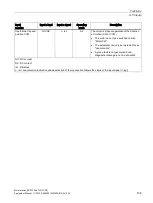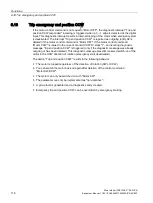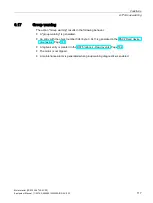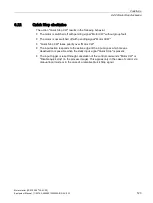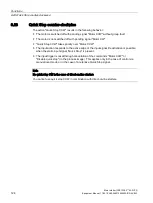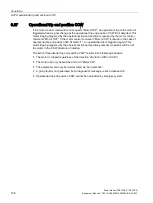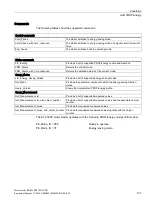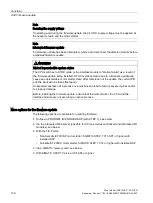
Functions
6.21 Quick Stop direction-independent
Motor
starter (3RK1308‑0**00‑0CP0)
Equipment Manual, 11/2019, A5E34821005002A/RS-AC/003
121
6.21
Quick Stop direction-independent
●
Motor is tripped without group fault.
●
"Quick Stop" takes priority over "Motor CW" and "Motor CCW"
●
The input action responds to the active edge of the input signal, which means that
deactivation is possible when the static input signal "Quick stop" is present.
●
The input trigger is reset through cancelation of the "Motor CW" and "Motor CCW" control
commands, or by means of "Disable quick stop" (in the process image). This applies only
in the case of control via manual local mode or in the case of a retentive Quick Stop
signal.
●
The motor is tripped regardless of the direction of rotation.
Example 1: Input 1 signal = retentive/edge-triggered
①
The motor is switched on by "Motor CW".
②
Motor is switched on by "Motor CW", then switched off by the rising edge at digital input 1
(parameterized to input action 1 = Quick Stop). By revoking the "Motor CW" command, the
Quick Stop function is reset.
③
Motor is switched on by "Motor CW", then switched off by the rising edge at digital input 1. By
setting Disable quick stop, the Quick Stop function is reset and the motor runs "CW" again until
the "Motor CW" command is revoked.
④
Motor is switched on by "Motor CW", then switched off by the rising edge at digital input 1. By
setting Disable quick stop, the Quick Stop function is reset and the motor runs "CW" again.
Although the static digital input signal 1 (DI2) is still present, the motor continues to run and is
only reset by revoking the "Motor CW" command.
Reason: The input action is edge-triggered.
⑤
Motor is switched on by "Motor CW" and continues to run uninterrupted since Disable quick
stop continuously overwrites the edges of the signal of digital input 1 (DI2).



